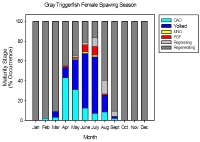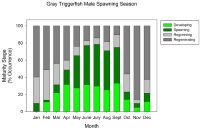Reef Fish Survey (RFS)
Marine Resources Monitoring, Assessment, and Prediction (MARMAP)
Reproductive Histology
Histology is the science of processing and studying the microscopic structure of tissue. Fishery scientists can collect many types of tissues and use histology to learn more about the condition, behavior, and life cycle of an organism. RFS biologists collect reproductive tissues (gonad tissue) from reef fish species and use histological processes to study their reproductive biology. These gonad samples are extracted from the fish and preserved until further work-up can be done.
The histological process typically takes multiple weeks, from the initial preservation of tissue to the final stage of interpretation under a microscope. Once tissue samples are collected they are first preserved in a fixative (11% formalin solution). Next, the samples are embedded and "blocked" in paraffin wax before extremely thin sections (<1/1000 of an inch, less than the width of a human hair!) are taken and placed on slides. These sections are dyed with stains that enhance specific cell structures within the tissue, allowing RFS biologists to study and evaluate each section.
Histological examination is time-consuming and costly but provides critical information used in managing fish populations. While macroscopic examination of gonad tissue can give general information about a species, the ability to microscopically evaluate tissue provides critical, detailed information such as: spawning seasonality, size/age of maturity, sex ratio analyses, and fecundity (total reproductive output of a fish). RFS biologists also study many fish species that are hermaphroditic, meaning they function as both sexes, either at the same time (simultaneously) or transitioning from one sex to the other (sequentially), during their lifetime. None of these important life history characteristics would be known without the use of histology.
The combination of histological data coupled with age, length, weight, diet, location, time of year, and other habitat analyses, usually results in a more complete picture of the status of fish populations. The RFS provides these data during stock assessments to develop a measure on the reproductive condition of a stock. Strategies can then be discussed and implemented to maintain and enhance fish populations.


